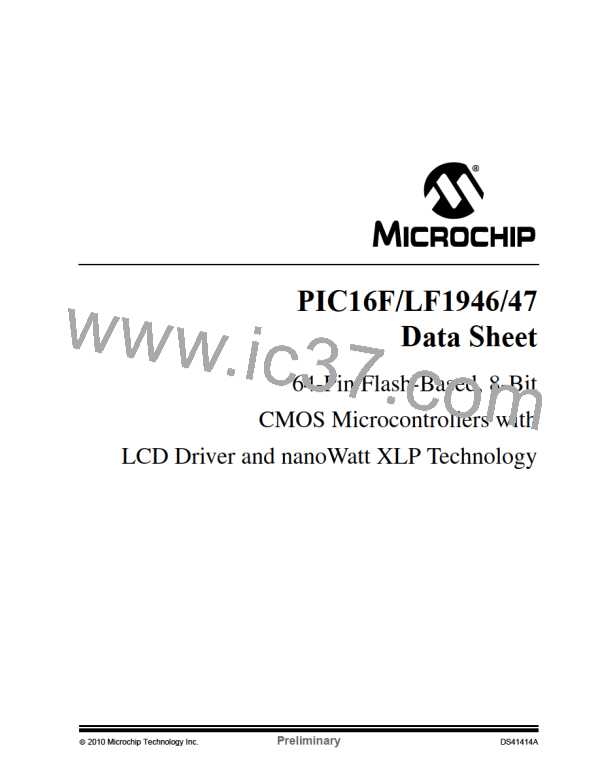PIC16F/LF1946/47
23.5.8 GENERAL CALL ADDRESS SUPPORT
In 10-bit Address mode, the UA bit will not be set on
the reception of the general call address. The slave
will prepare to receive the second byte as data, just as
it would in 7-bit mode.
The addressing procedure for the I2C bus is such that
the first byte after the Start condition usually deter-
mines which device will be the slave addressed by the
master device. The exception is the general call
address which can address all devices. When this
address is used, all devices should, in theory, respond
with an acknowledge.
If the AHEN bit of the SSPxCON3 register is set, just
as with any other address reception, the slave hard-
ware will stretch the clock after the 8th falling edge of
SCLx. The slave must then set its ACKDT value and
release the clock with communication progressing as it
would normally.
The general call address is a reserved address in the
I2C protocol, defined as address 0x00. When the
GCEN bit of the SSPxCON2 register is set, the slave
module will automatically ACK the reception of this
address regardless of the value stored in SSPxADD.
After the slave clocks in an address of all zeros with
the R/W bit clear, an interrupt is generated and slave
software can read SSPxBUF and respond.
Figure 23-23 shows
sequence.
a
general call reception
FIGURE 23-24:
SLAVE MODE GENERAL CALL ADDRESS SEQUENCE
Address is compared to General Call Address
after ACK, set interrupt
Receiving Data
D5 D4 D3 D2 D1
ACK
R/W = 0
ACK
General Call Address
SDAx
D7 D6
D0
8
SCLx
1
2
3
4
5
6
7
8
9
1
2
3
4
5
6
7
9
S
SSPxIF
BF (SSPxSTAT<0>)
Cleared by software
SSPxBUF is read
GCEN (SSPxCON2<7>)
’1’
23.5.9 SSPX MASK REGISTER
An SSPx Mask (SSPxMSK) register (Register 23-5) is
available in I2C Slave mode as a mask for the value
held in the SSPxSR register during an address
comparison operation. A zero (‘0’) bit in the SSPxMSK
register has the effect of making the corresponding bit
of the received address a “don’t care”.
This register is reset to all ‘1’s upon any Reset
condition and, therefore, has no effect on standard
SSPx operation until written with a mask value.
The SSPx Mask register is active during:
• 7-bit Address mode: address compare of A<7:1>.
• 10-bit Address mode: address compare of A<7:0>
only. The SSPx mask has no effect during the
reception of the first (high) byte of the address.
2010 Microchip Technology Inc.
Preliminary
DS41414A-page 265

 MICROCHIP [ MICROCHIP ]
MICROCHIP [ MICROCHIP ]